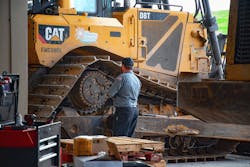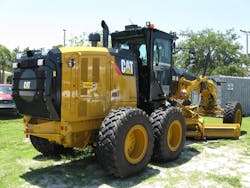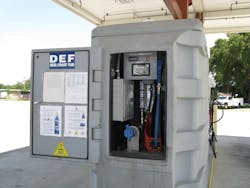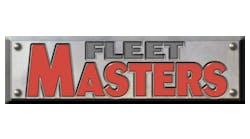Remember who took over the Green Bay Packers after Vince Lombardi? Or the Chicago Bulls after Phil Jackson? Unless you are a rabid fan, you probably don’t.
Matt Case, CEM, who followed Construction Equipment contributing editor Mike Brennan, CEM, as fleet manager for the Manatee County, Florida, Fleet Services Division, found himself in a similar position, following a three-time winner of the Construction Equipment and AEMP Fleet Masters Award.
But in short order, Case and his Manatee County staff won a title of their very own, capturing the 2020 Fleet Masters Award for large fleets (>$100 million estimated replacement value). The county now has an unprecedented four Fleet Masters Awards. (Read how small-fleet winner Kwest Group transformed its equipment department.)
Case, a member of the Under 40 in Construction Equipment Award Class of 2015, was most recently fleet operations chief for the county.
“It was exciting, and I knew I had big shoes to fill,” Case says. “But I wasn’t intimidated by the challenge. I had chosen everyone on our leadership team while in my previous position and I knew we could win another title, or multiple titles, with this group. I’m very ‘OCD,’ and I know the difference between good and excellent is in the details. I knew we could do more.”
Case’s and Fleet Services’ 2019 focus was channeled toward increasing fleet availability, improving preventative maintenance, scheduling more efficiently, facility management, and outsourcing.
“One goal in 2019 was to decrease costs by evaluating equipment utilization and streamlining lifecycle management,” Case says. “To do this, we evaluated asset utilization to identify low-usage equipment for redistribution to other areas within the fleet.
“Focusing on communication with outside departments was key, because it taught two things,” Case says. “First, it provided vital information about how equipment was being used across the organization. Second, it showed equipment in need of replacement. By evaluating the current needs of departments, not only was equipment redistributed, but operating capacity within the fleet organization also increased.”
Fleet standardization reduces equipment repair time
Case says that standardization of the fleet has improved availability of parts and reduced repair time, allowing equipment readiness to increase by 0.5 percent each quarter and achieve 79 percent same-day availability of parts.
“This reaches and exceeds industry standard goals,” Case says. “Standardizing the fleet equipment positively impacted repair times. By reducing the product lines, the focus was shifted to specific items, and multiple staff on site were cross-trained utilizing vendor education. This also reduced travel expenses and resulted in lower training costs.”
Lifecycle management was another area of focus, as Case wanted transparency across the fleet to achieve reduction of overall costs by replacing equipment at the right time. “We did this by analyzing shared information about equipment lifecycles to develop detailed time lines in the vehicle replacement program,” he says. “Risk mitigation analysis provided a foundation to support the financial impact of purchasing new equipment.”
The county’s updated replacement policy has allowed the team to more quickly evaluate assets, appraise current value, and prepare specifications to proceed with all replacement acquisition orders commencing at the beginning of the fiscal year.
“The standardization of equipment has also made the replacement process of procurement authorization more efficient with orders placed, on average, within 14 calendar days of the first fiscal day,” Case says. “Vendors are now able to promptly secure necessary asset allocation and orders are delivered faster. This, in turn, resulted in successfully attaining an additional $995,000 in capital replacement funding for the upcoming year and a maintenance cost savings of $200,000 during the first fiscal year.”
Case and his staff also made changes on the maintenance side. “The service team was restructured to better meet the needs of the growing fleet and meet benchmarked KPI,” he says. “This was achieved by reorganizing the workshop staff into teams, each concentrating on different specialties. This allowed the workflow to be controlled, overtime hours to decrease, and availability to increase by utilizing the most experienced people in each area.
“Centralized command centers were implemented to remove barriers that inhibited communication, work spaces were re-organized to be more functional, and all safety equipment, special tools, and software were updated and made accessible to all,” Case says. “Maintenance practices, preventative maintenance schedules, asset history, repair frequency, and downtime were reviewed, empowering our repair teams to take ownership of the barriers faced and innovative ways to solve them.”
Working with his parts management team, Case also increased stock levels to include all preventative maintenance components, and minimum and maximum limits. Reorder points were examined and reset.
“The practice of technicians researching needed parts was discontinued, and new vehicles were added to enable the parts team to deliver parts as needed to each site,” Case says. “Work order compliance was evaluated, and documentation standards were addressed to improve the flow of information and provide better transparency. Fleet personnel at all levels are now able to respond to customer queries and provide timely and accurate information regarding repair status.”
The county also looked at the type of work it was outsourcing. “Installation of additional equipment such as window tints, radio, and computer equipment prior to delivery of the new units is now outsourced,” Case says. “Also, major mechanical repairs are outsourced to minimize downtime and reduce the need for expensive but rarely used special tools.
“But we earned our biggest savings by outsourcing turf maintenance and preventative care. By using field service technicians to perform scheduled maintenance, transportation costs were eliminated and equipment availability was maximized.”
Customer service has also been a big part of Fleet Services’ focus.
“Peer-to-peer staff interaction with customers allows for timely communication and response to meet their service requirements,” Case says. “A vehicle control administrator is annually established with each individual work group to streamline scheduling service needs. Semi-annual meetings are held with major customer groups, then annually with smaller specific work groups to discuss utilization, potential vehicle assignment rotations, and targeted replacements.
“We establish and maintain policies identifying the priority of vehicles and equipment that are repaired and the type of work that takes precedence,” Case says. “This allows regular monitoring of minimum essential availability levels with customer groups, providing flexibility for preventative maintenance services without service interruption.”
Case is seeing a pay off. “Improvement of communication within our fleet succeeded in the exchanges of information being more descriptive and honest with less challenging, adverse situations, and it’s been recognized and complimented by peers,” he says.
The county also looked at the type of work it was outsourcing. “Installation of additional equipment such as window tints, radio, and computer equipment prior to delivery of the new units is now outsourced,” Case says. “Also, major mechanical repairs are outsourced to minimize downtime and reduce the need for expensive but rarely used special tools.
“But we earned our biggest savings by outsourcing turf maintenance and preventative care. By using field service technicians to perform scheduled maintenance, transportation costs were eliminated and equipment availability was maximized.”
Customer service has also been a big part of Fleet Services’ focus.
“Peer-to-peer staff interaction with customers allows for timely communication and response to meet their service requirements,” Case says. “A vehicle control administrator is annually established with each individual work group to streamline scheduling service needs. Semi-annual meetings are held with major customer groups, then annually with smaller specific work groups to discuss utilization, potential vehicle assignment rotations, and targeted replacements.
“We establish and maintain policies identifying the priority of vehicles and equipment that are repaired and the type of work that takes precedence,” Case says. “This allows regular monitoring of minimum essential availability levels with customer groups, providing flexibility for preventative maintenance services without service interruption.”
Case is seeing a pay off. “Improvement of communication within our fleet succeeded in the exchanges of information being more descriptive and honest with less challenging, adverse situations, and it’s been recognized and complimented by peers,” he says.
The fleet manager has ambitious plans for the future. Over the next five years, Case wants to address technological advancements, staff succession, emission regulations, and alternative fuels. Some of the efforts are already underway. Throughout, he sees staff involvement and communication as a key.
“Integrated decision-making processes and open engagement across departmental lines at all levels remain paramount to procure and maintain assets of the future which meet our customers’ requirements,” Case says. “We’re going to meet challenges and continue to gauge our effectiveness through constant review of workflow processes using Six Sigma theory and application. Staff has been invested in by updating the policies and succession plan, increasing salaries through a pay-for-performance merit system, and continuing a robust training program of over 1,000 contact hours in 2019.”
Manatee County’s fleet has already reduced its carbon footprint by using ultra-low-sulfur diesel fuel, purchasing Tier 4-F equipment, enforcing its anti-idling policy, and using office recycling programs.
Five-year technology and five-year capital budget funding plans have been developed and are underway, continuing to prove successful and cost-effective in support to the community, Case says.
“This fleet operation is team oriented,” Case says. “A.C.E., which stands for accountability, civility, and ethics, is our guiding principle and serves as our commitment to support each other, leading by example in pursuit of our mission and vision.”
It has proven to be a winning pursuit for the county’s new coach.








